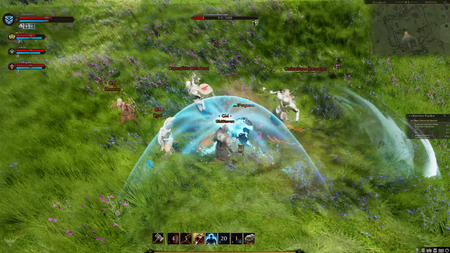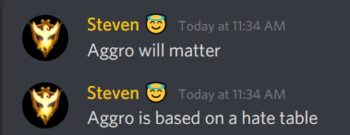| Glorious Wiki readers. We are adding the Midnight Magic video and livestream to the wiki. We appreciate your patience as we process the new and updated information! |
Aggro
La Amenaza (Aggro/Hate) se genera en función del daño infligido, la curación realizada, y los modificadores de ciertas habilidades.[1][2]
- En PvE, el agro contra personajes jugadores se basa en una tabla de odio.[2]
- En Pvp, el aggro puede forzar el cambio de objetivo al tanque. Durante las pruebas se pedirán opiniones al respecto.[3]
- If we think about PVP settings and the role of taunt or hate, a lot of times for tanks in the MMOs that I've played- where you have a PvE and PvP scenario- those types of hate generation abilities don't really have cross application into the PVP realm; and that can feel bad, because typically a tank build-out can be delegated around how I generate hate; and if it has no cross application into PvP then effectively you're creating a class composition that just is not relevant in half of the game, or in that area of the game. So when we talk about how we're going to apply hate to player targets or taunt to player targets, sometimes that can move into the realm of target switching, or the ability to demand that target on the tank in a PvP scenario as well. That's something that we need to get player feedback on, because there's a lot of strong emotions around that type of mechanic. I for one am a big proponent of that. I think it's interesting. I think that it plays into the role of the tank and that it it hits a class fantasy that most tank players want to feel. And I think however on the flip side of that, it is a source of control; and anytime you're under the effects of some source of control, it's going to be a feel bad moment for the target that's being controlled. So that's why I think it generates a lot of feelings on both sides of the aisle.[3] – Steven Sharif
- "Detargeting" es el acto de eliminar el odio/amenaza/aggro de un enemigo.[3]
- Habrá una habilidad de provocar disponible en niveles más altos de lo que se ha visto hasta ahora en el Alpha-2.[4]
- Q: There were a lot of concerns about threat [in the Alpha-2 Tank preview video]. A lot of people didn't understand how holding threat works, because you weren't holding threat at some point.
- A: It's important to remember that these previews are done at a very low-level, so these are low-level skills and abilities that the archetypes have available to them; and so because of that, some of the functionality from these abilities they don't necessarily perform as well as you would want them to in a later stage of the game for that role. Now also keep in mind that balance is a perspective that needs to be incorporated also. So, threat is generated based off of a few factors: It's based off of damage done, it's based off of healing done, it's based off of threat generation modifiers that are on abilities. Now the tank in this situation I believe has two abilities that are going to generate additional threat. They have the slicing- the number two ability; and then they also have the shout ability. Both of those are creating additional threat. But with that being said, we need to tune probably those abilities up a little bit to contend with the DPS that's coming both from the ranger and with the heals that are coming out of the cleric.[1] – Steven Sharif
| Habilidad | Icono | Rango 1 | Rango 2 | Rango 3 |
|---|---|---|---|---|
| Ancestral Bolas | 
|
Throws a magical web of bolas at the target location. All enemies within are snared and build additional hate towards the tank every second. Enemies entering or exiting the radius will be tripped.[6] | ||
| Grapple | Takes aim for a moment before hurling a hooked chain in a line, damaging the first target it contacts and immediately pulling them to the caster. The target suffers a tapering snare for 3 seconds.[7][8] | |||
| Hatred | 
|
Single target that adds hate.[5] | Add a forced target lock.[5] | Add hate over time per tick.[5] |
| Inciting Strikes | Slashes twice in a forward cone while adding additional threat.[9] | |||
| Shield Assault | Bashes the target with your shield, dealing damage and applying the shaken condition. If the target is already suffering from the shaken condition, stun the target instead.[10] | |||
| Slam | 
|
Slam your target with immense force, knocking them back. Applies 10 stagger. Deals 500% additional threat.[11] |
Evaluación de la amenaza
You decide to gank the player, but find out that you have been ambushed![12]
Los jugadores tendrán un indicador en su placa de nombre que indicará el equipo que llevan. Los demás jugadores podrán ver este indicador si apuntan al jugador a distancia.[13][14][15]
- You can target a player. You're going to see what type of armor they have based on a buff they have available to them because obviously cosmetics can change appearance. You might have different silhouettes as a result of that.[16] – Steven Sharif
- El borde indicará el nivel y la calidad del set.[13][14][17]
- Los desarrolladores creen que inspeccionar el equipo para obtener una lista exacta de equipo o la puntuación del mismo puede dar lugar a "comportamientos no deseados".[19]
- When you see a player approaching you and they're wearing a transmog you don't know if that person is a high damage mitigation against physical damage or against magical damage and essentially the way we overcome that is through you being able to target a player at a distance and they will have a buff that's present on them that you will see, which indicates that essentially the piece set that they are wearing. It is important for players to be able to ascertain from a threat assessment standpoint what they're going up against if they're actively checking that, and that will be available.[15] – Steven Sharif
Salud
La salud es una estadística en Ashes of Creation.[20][21]
- Los jugadores que no estén en el mismo grupo, raid, allianza, o gremio no podrán ver los porcentajes de salud de otros jugadores ni los valores exactos de sus barras de salud.[22][20][21]
- La placa de identificación de un jugador se deteriorará para dar una indicación de cuánto daño ha recibido..[20][21][23]
With regards to seeing another player's health: As you know their name plate will deteriorate or give you an indication of like hey they've taken damage they're significantly injured, but you're not going to get a percentage. You're not gonna get an exact bar value, unless you're in their party or in their raid.[21] – Steven Sharif
Nameplate

Nameplates really actually require a big refactor on our end that we haven't done yet. However, that is something that tech art and engineering, as well as our UX/UI team are going to be doing over the course of probably the next month to month and a half. It's a big refactor both from performance reasons- how we're going to be able to occlude those nameplates within world obstacles and line-of-sight as well as prioritizing and clamping their sizes and distances that need a bit of a refactor; and of course their visual appearance. So that's work that's still outstanding.[25] – Steven Sharif
La placa del nombre del personaje se muestra sobre su cabeza.[26]
- Puede ser el nombre, y de forma opcional el apellido.[26]
- El nombre de la guild del personaje se muestra al lado del nombre del mismo.[27]
- La placa del nombre del personaje se irá deteriorando para indicar cuanto daño ha recibido.[20][21][23]
- La clase se identificará mediante un icono.[13]
- Al pasar el ratón sobre la placa del nombre del personaje se mostrará información como el nivel, su clase el combo de arquetipo.[13]
- Un icono de "buff" indica el grado y equipo del personaje.[13][14][15]
- El tamaño y la prioridad de las placas de nombre dependerán de su distancia (de la cámara).[25]
- La visibilidad de placa del personaje se podrá esconder por objetos del juego, como los árboles; con habilidades de utilidad, como camuflaje o sigilo; o mediante el uso de disfraces.[28][29]
- Las configuraciones de la UI permitirán esconder las placas de nombre, cambiar el tamaño y personalizarla.[30]
- El tipo de criatura invocada por el invocador aparece en la placa encima de la invocación. El jugador no puede cambiarlo. [31]
- Las placas con los nombres de los enemigos tendrán indicadores que identifiquen las resistencias, buffs, y rango de elite.[32]
- Se puede utilizar un indicador en forma de estrella para indicar la ubicación de los puntos de golpe.[32]
Ver además
Referencias
- ↑ 1.0 1.1 Transmisión en vivo, 2023-01-27 (1:04:34).
- ↑ 2.0 2.1

- ↑ 3.0 3.1 3.2 Transmisión en vivo, 2023-02-24 (1:25:11).
- ↑

- ↑ 5.0 5.1 5.2 5.3 Transmisión en vivo, 2017-10-16 (21:48).
- ↑

- ↑ Vídeo, 2023-03-31 (9:55).
- ↑ Vídeo, 2023-01-27 (10:27).
- ↑ Vídeo, 2023-01-27 (6:41).
- ↑ Vídeo, 2023-01-27 (5:07).
- ↑

- ↑ Twitter - Better luck next time.
- ↑ 13.0 13.1 13.2 13.3 13.4 Transmisión en vivo, 2020-08-28 (2:07:26).
- ↑ 14.0 14.1 14.2 14.3 14.4 Transmisión en vivo, 2020-07-25 (53:08).
- ↑ 15.0 15.1 15.2 Transmisión en vivo, 2020-06-26 (1:28:10).
- ↑ 16.0 16.1 Pódcast, 2021-09-29 (52:58).
- ↑ 17.0 17.1 Transmisión en vivo, 2017-07-28 (1:34:55).
- ↑ Official Livestream - May 4th @ 3 PM PST - Q&A
- ↑ Transmisión en vivo, 2017-07-28 (23:20).
- ↑ 20.0 20.1 20.2 20.3 Transmisión en vivo, 2020-07-25 (1:33:37).
- ↑ 21.0 21.1 21.2 21.3 21.4 Transmisión en vivo, 2020-01-30 (1:40:48).
- ↑ 22.0 22.1 Transmisión en vivo, 2021-07-30 (1:10:34).
- ↑ 23.0 23.1

- ↑ Vídeo, 2023-01-27 (24:17).
- ↑ 25.0 25.1 Transmisión en vivo, 2023-01-27 (1:08:45).
- ↑ 26.0 26.1 Entrevista, 2018-05-11 (2:45).
- ↑ Transmisión en vivo, 2017-05-22 (51:00).
- ↑ Transmisión en vivo, 2022-10-14 (48:45).
- ↑ Transmisión en vivo, 2022-09-30 (1:23:28).
- ↑ Transmisión en vivo, 2022-12-02 (1:03:28).
- ↑ Transmisión en vivo, 2021-01-29 (1:21:01).
- ↑ 32.0 32.1 Transmisión en vivo, 2023-01-27 (1:09:36).